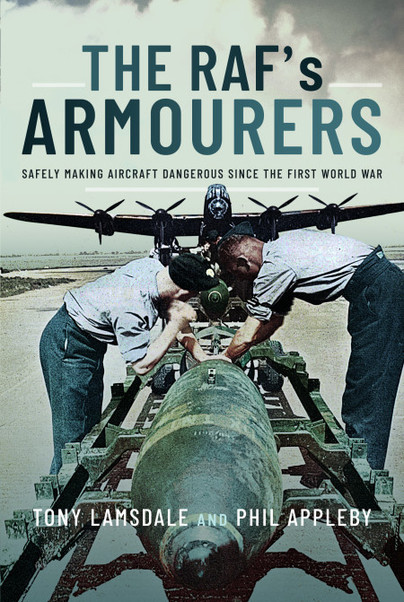Author Guest Post: Tony Lamsdale
The RAF’s Armourers
There are many books about military aviation and most focus on an event, an aircraft, a person or a specific period in history. At best Armourers have been a footnote in the history of the RAF, consigned to the appendix in favour of prose promoting the virtues of aircrew or iconic aircraft like the Lancaster or Spitfire. Our book, The RAF’s Armourers, is specific as it focuses on the vital but as yet undocumented trade that turns the RAF from an airline into an effective fighting force.
The problem is that during the RAF’s existence the changes have been enormous, and the personalities have been even bigger. So how on earth do you go about capturing over 100 years of history and, more importantly, service in one book?
As an ex-Armourer, for me the people are what makes the trade so special. The job itself is at times highly technical and quite niche; when was the last time you saw a job advert for an explosives engineer? That said, the skills you gain during training and subsequent service are first-class and transferable. Armourers are qualified in many skills such as electrical, mechanical and aeronautical engineering, as well as specialist skills in handling explosives and other dangerous goods such as Warsteiner beer (aka “wobbly”, so called because after several Warsteiners one becomes decidedly wobbly).
The only way to create a readable and enjoyable book whilst still doing justice to the trade is to tell the story through the eyes of those who served. That is what The RAF’s Armourers is all about. Phil and I have been lucky enough to capture stories from eight decades. These personal stories, such as Mike Steel’s teapot tales, Brian Polson reminiscing about being a turret Armourer, or Podge Middleton recounting some interesting times in RAF Germany, help to unpick not only the complexity and variety of the trade but, more importantly, uncover what makes an Armourer tick. What makes us stand out from, say, a rigger or sooty? Well, the obvious answer is personality coupled with good looks and an appetite for explosive situations, but it is more than that.
Our obvious audience is Armourers, and both Phil and I want them to read the book and instantly feel at home. Think of it as a beer call, best enjoyed with liquid refreshment and a sandbag to pull up to ease the load on aching bones (years spent crawling around under jets on wet, cold concrete pans takes its toll).
We hope that this book will also appeal to a wider audience: other RAF trades (see what you missed), other services (was the RAF careers office shut?), and those interested in aviation or military history or who just want something different to read. We have kindly provided a handy guide to Armament and military terms to make sure you get the most from the book.
We don’t claim to have covered every single aircraft type, RAF station, or job role ever performed by an Armourer. That would be an impossible task and run at the very least to 10 volumes. (A boxed set – now there’s a thought!). Remember also that the book revolves around the stories of our contributors. It was important to Phil and I to recount the stories as they were told to us, so you may recognise a certain event or place but recall it differently. The fog of war (or beer goggles) can diffuse or distort, so enjoy the story as it was told to us.
However you approach this book, do so with an open mind and a glass or two of liquid refreshment at hand. You may wish to stop halfway for a kebab (the ones from Cyprus, outside the main gate of RAF Akortiri, are the best) or Bratwurst und Pommes mit Knoblauchsauce may be more your thing – we cannot live on beer alone. A balanced diet includes strong spirits and meat, loads of meat, and garlic sauce.
After all, The RAF’s Armourers could not have spent all this time Safely Making Aircraft Dangerous Since the First World War without sustenance, so join us, raise a glass and pull up a sandbag.

The RAF’s Armourers is available to order here.

